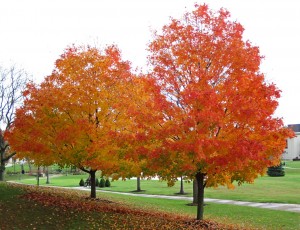From the Opinion Editorial of Rebecca Phillips, Parkersburg News & Sentinel, January 21, 2023
If you are like me, you look forward to each year’s maple syrup crop. After tasting the real thing, the artificially flavored and colored substance that passes for syrup in most grocery stores is a sad imitation. Ohio has a long history of maple syrup production, going back to its indigenous peoples, and is the fourth-largest producer of maple syrup in the U.S.
With more than 900 producers, mostly small businesses, the maple industry adds about $5 million to our state’s economy each year, according to the Ohio State University — not bad for a niche crop that can live for over 300 years. In West Virginia, maple products are helping small farmers succeed while preserving woodlands on their property, as witnessed by the state’s annual Maple Days.
Unfortunately, this long tradition and the economic boost it provides are endangered by our changing climate. The sugar maple requires specific conditions to thrive, and even more specific conditions for peak sap production. Scientists are warning that those conditions may cease to exist in our region within the next few decades.
During the growing season, maple trees store starch, a process that ends with leaf fall. The starch stored over the summer and fall converts to sugar when the temperature of the tree’s wood reaches 40 degrees or so, and the sap rises. In Ohio, the tapping of maple trees generally begins in late January when, historically, conditions have been right for optimal sap flow — daytime temperatures in the low 40s and nights slightly below freezing.
The tapping ends when the trees bud out, something that is happening earlier in the season than it once did due to earlier spring thaws. A shorter season means less maple syrup and reduced income for producers. Higher temperatures also result in reduced sugar content in the sap, making it not as good for syrup production.
Erratic weather is also bad for the trees themselves. Early extreme cold such as the Christmas freeze we recently experienced can damage roots and slow tree growth, especially when there is no snow pack. Early warmth and late frosts can kill the year’s first leaf buds, forcing trees to expend energy growing a new set of leaves. These combined stresses, besides reducing sap production, can harm the long-term health of the trees.
Climate change is harming maple forests in other ways. Sugar maples evolved in relatively cool climates with abundant rainfall; they do not tolerate heat or drought well. Unfortunately, according to the U.S. Army Corps of Engineers, the Ohio River Valley is likely to see heavier rainfall over short periods of time interspersed with summer drought.
All predictions are for more days exceeding 90 degrees. Increased temperatures mean that insect seasons are longer, and while insects are a vital part of all ecosystems, a warmer climate is allowing certain invasive species to thrive. Pear thrips, tiny insects originally from Europe, are thriving in the northern half of the U.S. and, despite their name, damaging millions of acres of maple forest, over a million in Pennsylvania alone.
It is true that we are unlikely to see a massive sugar maple shortage in the near future, these trees being as long-lived as they are. Recent studies from several universities and the Department of the Interior, however, indicate that seed germination is likely to decrease, and the range of these magnificent trees will slowly move north, possibly vanishing from the southern part of their range (Virginia, West Virginia, and southern Ohio) by 2100. It is likely that the cool overnight temperatures required for optimum sap movement will decrease, and that our region may not be able to sustain syrup production for more than a few more decades.
This is bad news, but at least for now, we can enjoy this gift of the forest while supporting the small farmers who produce it — before a changing climate takes it away from us.
***#####***#####***#####***#####***#####
>>> Rebecca Phillips is a retired professor from WVU Parkersburg. A member of Mid-Ohio Valley Climate Action, she is also on the coordinating committee for the Fort Street Pollinator Habitat in Marietta, OH.
$$$$$$$@@@@@@@$$$$$$$@@@@@@@$$$$$$$@@@@@@@
SEE ALSO: Sugar Maple Research to Save the Trees & Syrup Industry ~ Climate research on maple tree sap ~ Maple Watch has its focus on the color of the maple tree sap, From a Bulletin of Forest Watch, Univ.of New Hampshire, October 2017
$$$$$$$@@@@@@@$$$$$$$@@@@@@@$$$$$$$@@@@@@@@
SEE ALSO: ‘This is our forest’: Climate change means uncertain future for maple trees, syrup season, Dinah Pulver, Phys-dot-org News, May 16, 2022

